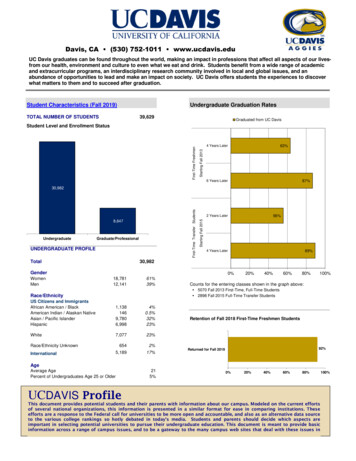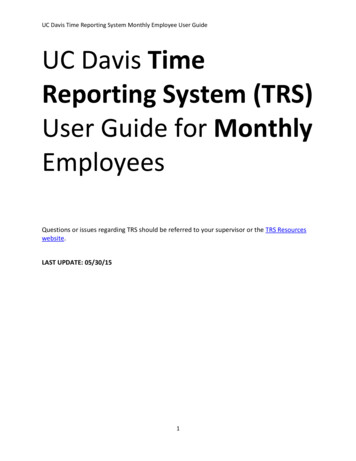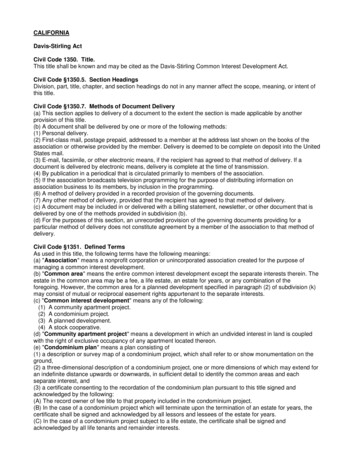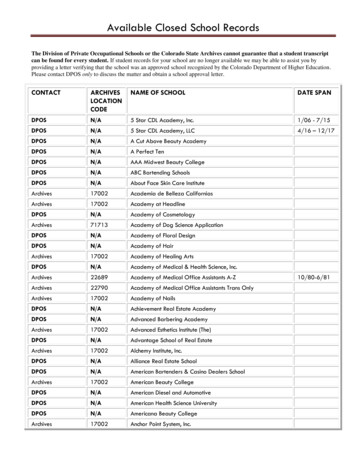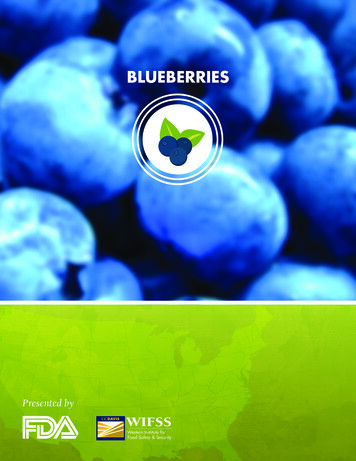
Transcription
BLUEBERRIESPresented by
BLUEBERRIESThis production summary provides an overview of growing, harvesting, and post harvesting practices. There aresome common practices that many large commercial growers use when producing blueberries, and though there arevariations in these practices, having an understanding of the most common methods used will be helpful when carryingout regulatory activities.By the end of this summary, you will be able to:1. Describe the differences among the varieties of commercially produced blueberries.2. List the top blueberry producing regions in the U.S.3. Identify common farming practices used in the production of blueberries.4. Describe farming practices used in different blueberry growing regions.INTRODUCTIONThere are three commercially importantspecies of blueberries that are native to theEastern United States:1.“Highbush”2.“Lowbush” and3.“Rabbiteye”so the rest of this summary will focus on these species. Mostfresh market blueberries are from highbush plants and mostprocessed blueberries are from lowbush plants.The United States is the world’s largest producer ofblueberries. They are also grown in Chile, Argentina,Colombia, and British Columbia. Blueberries are growncommercially in 38 states with Michigan leading productionof cultivated blueberries in the U.S. Other top producingstates include New York, New Jersey, North Carolina,Georgia, Florida, Mississippi, Indiana, California, Oregon,and Washington (Fig 1). Maine is the leading producerof “wild” lowbush blueberries. Highbush and lowbushblueberries are native to the Eastern United States.Fresh blueberries are available year round to U.S. consumersdue to regional growing areas in the U.S. and imports fromother countries. North American blueberries are sold fromWithin each species, there are many cultivars or varieties.Blueberry cultivars are chosen based on production areatemperature and the chilling requirements of differentspecies. Chilling is the accumulated number of hoursbetween 32 and 45 F necessary for flower buds to developon a dormant plant.Rabbiteye and highbush plants require fewer chilling hours toproduce fruit and are well adapted to Florida and California’smoderate climate. Lowbush species are native wild blueberryplants; however, they are still managed intensively withproduction techniques. Highbush and lowbush species arethe most common species grown for commercial productionFig 1 - Top Blueberry Producing States in the USBLUEBERRIES 2
April through October, with the peak season from mid-Juneto mid-August. South American blueberries are importedfrom November through March.GROWINGBlueberries require acidic soil withan optimal pH of 4.8. Nitrogen andammonium sulfate fertilizers are used toincrease soil acidity. Preparing a site forplanting may take several years.Blueberry bushes are perennials and most growers planttwo-year-old bushes sourced from wholesale nurseriesor propagated from their own cuttings. Fall planting ispreferred and annual pruning is required. Some growersin the Southeast U.S. plant blueberries under polyethylenetunnels. This helps reduce damage during freezes andpromotes higher yield and earlier fruit in the spring.During spring, bushes produce white blossoms that arepollinated by bees. Each blossom will eventually becomeone blueberry, first hard and green, then reddish-purple, andfinally, blue. Bushes will grow larger berries if they are crosspollinated with a different variety. Growers will removeflowers and fruit for the first two to three years to promotevigorous bush growth. Eight to 12 years are usually requiredfor blueberry plants to reach full size and greatest yield.Most farms irrigate with overhead sprinklers, which arealso used for spring frost protection. Above ground dripirrigation is less common and usually used on farms withlimited water supplies. Some Midwest and Southeasterngrowers use surface water to irrigate their plants. In thiscase, microbiological testing of surface water is doneto avoid bacterial contamination and spray irrigation isdiscontinued prior to harvest.Insects and weeds are controlled by using high-pressuresprayers to deliver preseason and post season insecticidesand herbicides. Organic growers can use integrated pestmanagement strategies including the addition of mulch orplastic coverings to aid in weed suppression.Harvest begins in the south andmoves northward. Florida productionHARVESTINGstarts in early April. The Californiaharvest typically begins in early Mayand continues for about eight weeks.Michigan’s blueberry harvest usually runs from early July tomid-September.Fresh market fruit is generally harvested by hand. Thisallows selection of ripe fruit with little bruising. Pickerscarry five-quart collection buckets on their belts. Whenfilled, the worker will empty the buckets or exchange it forempty buckets with a harvest supervisor.Some growers conduct the first pick by hand for freshmarket and later harvest by machine for either the freshmarket or processed market depending on fruit conditionand current market prices. Mechanical harvesters straddlethe row shaking the bushes with mechanical fingers toremove ripe berries. The ripe berries fall into a catch frameand are conveyed into plastic field lugs that carry about20 pounds of fruit. Fields that are machine harvested areusually harvested multiple times to retrieve all mature fruit.Within hours of picking, berries aretransported by truck to a packinghouse.PACKINGContainers of berries are loaded ontoconveyors that carry the berries toblowers, which remove leaves, sticks, andunderweight berries. Blueberries for the fresh market are aircleaned to remove debris. All berries are then graded andsorted. Fruit destined for the fresh market are packed inclear plastic clamshells.BLUEBERRIES 3
Blueberries are typically cooled by forced air at 35 F. Forcedair cooling is accomplished by placing a row of palletsnext to an intake fan. A large tarp is placed over the palletsand the fan draws the refrigerated warehouse air throughopenings in the cardboard boxes and plastic clam shells.Cooling delays decay and prolongs shelf life.Late season berries may be stored for several weeks inmodified atmosphere chambers to capture higher prices atthe end of the season. Cooled blueberries are shipped tomarkets in refrigerated trucks between 34 to 36 F.CONCLUSIONHaving a basic understanding of the way blueberries are grown, harvested, packaged, cooled,and held will provide the basic background information that will be helpful to regulators whencompleting inspections or investigations in the field.The agricultural practices described in this production summary are common on most large commercial farmslike those found in major blueberry producing regions in the United States. There are undoubtedly variationsin these practices depending on the region, operation size, and individual grower preferences. This is especiallytrue of farms outside of the U.S.BLUEBERRIES 4
REFERENCES“Blueberry Variety Selection.” Santa Barbara County Cooperative Extension. University of California Division of Agriculture andNatural Resources, n.d. Web. 6 Jan. 2016.Carpenter, Francis, Kevin R. Day, Manuel J. Jimenez, Richard H. Molinar, Kathryn Wright. “Blueberry research launches excitingnew California specialty crop.” California Agriculture. University of California, Agriculture and Natural Resources, Mar. 2004.Web. 6 Jan. 2016.Ingles, Chuck, John Gregory, Cathy Coulter. “Growing Blueberries in the Sacramento region.” Environmental Horticultural Notes.University of California Cooperative Extension, Mar. 2004. Web. 6 Jan. 2016.Keough, Gary R. “Maine Wild Blueberries.” New England Agricultural Statistics. United States Department of Agriculture, NationalAgricultural Statistics Office, 15 Mar. 2012. Web. 6 Jan. 2016.Longstroth, Mark. “Using Sprinklers to Protect Blueberries from Spring Freezes.” Michigan State University Extension, n.d. Web.10 Jan. 2016.Longstroth, Mark. “The annual cycle of growth of northern highbush blueberry.” Michigan State University Extension, n.d. Web.10 Jan. 2016.Longstroth, Mark, Eric Hanson. “The Michigan Blueberry Industry.” Michigan State University Extension, n.d. Web. 10 Jan. 2016.“Overview of the US Blueberry Industry.” Santa Barbara County Cooperative Extension. University of California Division ofAgriculture and Natural Resources, n.d. Web. 6 Jan. 2016.Williamson, J.G., J.W. Olmstead, P.M. Lyrene. “Florida’s Commercial Blueberry Industry.” University of Florida, IFAS Extension,n.d. Web. 6 Jan. 2016.Funding for this presentation was made possible, in part, by the Food and Drug Administration through Cooperative Agreement 1U54FD004327. Views expressed in thispresentation do not necessarily reflect the official policies of the Department of Health and Human Services; nor does any mention of trade names, commercial practices, ororganization imply endorsement by the United States Government.BLUEBERRIES 5
starts in early April. The California harvest typically begins in early May and continues for about eight weeks. Michigan's blueberry harvest usually runs from early July to mid-September. Fresh market fruit is generally harvested by hand. This allows selection of ripe fruit with little bruising. Pickers
